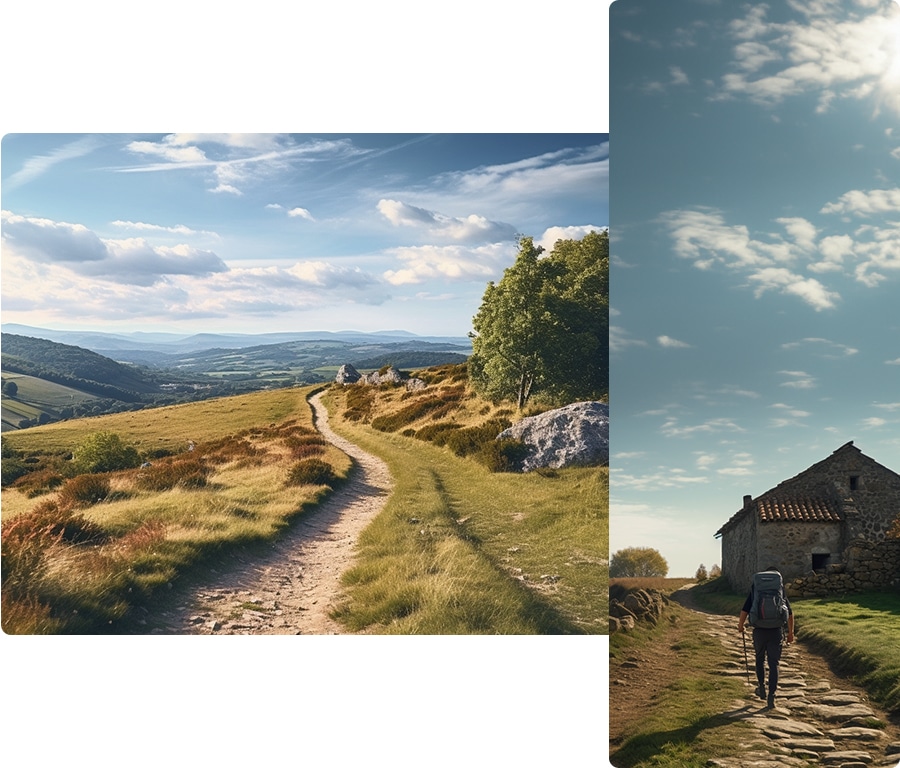Way de Santiago from Bilbao to Santander
Discover the beauty of the Cantabrian Sea and the cultural richness of northern Spain with Mundiplus.
The Camino from Bilbao to Santander organized
Begin your pilgrimage in Bilbao, a city of art and gastronomy, and let yourself be amazed by its urban atmosphere and the iconic Guggenheim. Continue along coastal ways where the murmur of the Cantabrian Sea and the landscape of cliffs accompany you, passing through historic towns like Castro Urdiales and Laredo, known for their maritime heritage.
Immerse yourself in the spirit of the Cantabrian coast
A journey that renews your vision
Way
Begin your pilgrimage in Bilbao, a city of art and gastronomy, and let yourself be amazed by its urban atmosphere and the iconic Guggenheim. Continue along coastal ways where the murmur of the Cantabrian Sea and the landscape of cliffs accompany you, passing through historic towns like Castro Urdiales and Laredo, known for their maritime heritage.

Each step of this way is designed to offer you moments of introspection and discovery. Enjoy the perfect fusion between the innovative culture of Bilbao and the serenity of Santander. Here, monuments like the Palacio de la Magdalena and the beaches of El Sardinero invite you to reconnect with nature, history, and your own emotions.

More details
Origin
Bilbao

Destination
Santander

Duration
7 days / 6 nights / 5 stages

Total Kms
111,66

Price / person
Consult
Book now!
Please indicate the number of people

servicios
Services
Comprehensive and customizable services so you can enjoy them without worries.
Services Included
- Accommodation in selected hotels, rural houses and hostels.
- Special breakfast to start each day with energy.
- Travel assistance insurance valid throughout Spain.
- Assistance vehicle available in case of emergency.
- Informative digital dossier on the Camino.
- Telephone assistance on the road.
- Luggage transfer at each stage (1 suitcase per person up to 20 kg).
- Special gifts: Pilgrim's Credential, Scallop Shell, and a typical Galician product.
- No cancellation fees up to 10 days before starting the Camino.
- VAT included in the price.
Optional services
- Possibility of dividing long stages into more days.
- Extra night in Santiago de Compostela.
- Cancellation insurance for residents in Spain and abroad.
- Day trips to nearby destinations.
- Option to carry additional luggage if you need more than 1 suitcase.
Remember that the cost of any optional services you choose will be added to the base price of your tour. We are committed to making your pilgrimage an unforgettable and worry-free experience.
Stages of the Northern Way from Bilbao to Santander
This itinerary can be completed in 7 stages plus the arrival and farewell.
Day 1: Arrival in Bilbao. Lodging.
You will arrive in Bilbao, the city that marks the beginning of your journey along the Way of the North. Upon arrival, you will have the opportunity to marvel at its unmistakable blend of modernity and tradition. Stroll through the Old Town, admire the architecture of historic buildings, and let yourself be captivated by the atmosphere that fills every corner.
Be sure to visit the Guggenheim Museum, a symbol of the city’s urban and cultural renewal. During this first day, we recommend enjoying a meal at one of the many restaurants where Basque cuisine is expressed through unique and flavorful dishes.
After a free afternoon, you will be assigned comfortable accommodation, ideal for resting and recharging your energy for the beginning of your pilgrimage.
Day 2: Bilbao – Portugalete Stage (19 km)
- Duration: 3–4 hours
- Difficulty: Low
Starting from Bilbao, this stretch immerses you in the transition from an urban environment to a riverside landscape. The way follows the course of the Nervión River, allowing you to enjoy panoramic views of the riverbanks and observe how modernity and industrial tradition intertwine.
Along the way, you will find small viewpoints offering privileged vistas, as well as architectural details that tell the story of the Basque Country. As you advance, the iconic Vizcaya Hanging Bridge gradually comes into view, a reminder of 19th-century engineering and a World Heritage Site.
The mostly flat way allows for a relaxed pace, ideal for acclimatizing to the Way experience. Upon reaching Portugalete, you will be welcomed by the local hospitality and will stay in accommodation that will prepare you for the next stage, full of new discoveries.
Day 3: Stage Portugalete – Castro Urdiales (27 km)
- Duration: 6–7 hours
- Difficulty: Medium
In this stretch, the way opens up to the immensity of the Cantabrian coastline, combining the strength of the sea with landscapes of land and sky. Leaving Portugalete, the way leads into coastal trails that unfold alongside beaches and cliffs, where the constant murmur of the waves and the sea breeze accompany each step.
The terrain, with gentle ascents and descents, moderately challenges your energy as you cross farmland and small population centers. As you approach Castro Urdiales, the silhouette of its castle and the majestic Gothic church announce your arrival at a site rich in fishing history and tradition.
Day 4: Stage Castro Urdiales – Laredo (27 km)
- Duration: 6–7 hours
- Difficulty: Medium
Today’s stage immerses you in a journey that combines historical heritage with coastal landscapes of great beauty. Departing from Castro Urdiales, the way opens up to trails that follow sections along the sea and rural paths, allowing you to admire fine sandy beaches, rugged cliffs, and small settlements. The moderately demanding route includes ascents that invite you to pause and take in the surroundings, and descents that ease your progress.
Upon reaching Laredo, famous for its extensive beach and its charming old town, you will feel the influence of a seafaring tradition that is present in every corner. This stage, full of contrasts and emotions, offers you moments of pause and reflection.
Day 5: Laredo – Guemes Stage (27 km)
- Duration: 6–7 hours
- Difficulty: Medium
This stage leads you into a more serene and rural atmosphere, inviting you to discover the heart of the Cantabrian landscape. The way unfolds along paths surrounded by wide fields, small forests, and villages that preserve the authentic flavor of local tradition.
The mostly flat way encourages a slow, contemplative pace, where every detail of the surroundings becomes the protagonist. Along the way, rural life reveals itself in simple forms: stone houses, vegetable gardens, and the hospitality of its people.
Arrival in Güemes marks the end of a day that celebrates the tranquility and beauty of the countryside. It offers you a well-deserved rest in cozy accommodation, perfect for recharging your energy for the final stage of the Way.
Day 6: Stage Guemes – Santander (12 km)
- Duration: 3–4 hours
- Difficulty: Low
The final stage leads you to Santander, marking a smooth transition from countryside to city. The flat way allows you to enjoy a relaxed walk through landscapes of green meadows and small inhabited settlements. With every step, the environment gradually transforms, and the presence of the Cantabrian Sea becomes more and more evident, announcing the imminent arrival at the urban coast.
Santander, with its iconic promenades, wide plazas, and a bay that shines under the sun, symbolizes the culmination of this stage. Upon arrival, comfortable accommodation awaits you, offering a place to rest and reflect on the experience lived.
Day 7: Breakfast-End of our services
The last day of our journey begins with a breakfast in Santander, celebrating the end of an experience full of discoveries and emotions. On this final day, you will enjoy a gastronomic offering that blends traditional flavors with contemporary touches, reminding you of the cultural diversity of the North.
Once our services are concluded, you can take the opportunity to explore its streets, admire iconic monuments, or simply relax by the coast.
Along the way, you will discover picturesque towns and cities while immersing yourself in the rich history and tradition of the Camino de Santiago. Be sure to book accommodation in advance. Enjoy the Camino and its spectacular landscape!
Accommodation
On each stage of the journey, we make your rest our priority.
To achieve this, we have carefully selected establishments that combine comfort and exclusivity, offering private rooms with en-suite bathrooms and all the essential services for a relaxed stay. We move away from the hostel option to offer you an intimate and serene environment, where privacy and quality are essential.
Since availability may fluctuate depending on the season, we will inform you of the name and specific details of each accommodation once your reservation is confirmed and the dates are verified. Our commitment is to ensure that you focus on enjoying the Camino while we take care of providing you with a unique and seamless experience every night of your pilgrimage.

Questions of interest
What to eat and typical dishes on the Wey of Santiago from Bilbao to Santander?
This stretch offers a variety of attractions that enrich the pilgrim’s experience.
- In Bilbao, the Guggenheim Museum, the Old Town, and the city’s cultural life stand out.
- In Portugalete, the iconic Hanging Bridge adds a historical and industrial touch.
- Castro Urdiales surprises with its castle and Gothic church.
- Laredo captivates with its extensive beach and seafaring old town.
- Finally, Santander offers monuments such as the Magdalena Palace, seaside promenades, and a spectacular bay.
What is the recommended time of year to walk this route, considering the weather conditions and the number of pilgrims?
The ideal times to walk this stretch are spring (April to June) and autumn (September and October). During these months, temperatures are moderate and there are fewer pilgrims, resulting in a more comfortable and less crowded experience.
Although summer offers longer days, the heat and the higher number of visitors can affect the pace of the way. In contrast, during winter, some services may be limited due to weather conditions.
What cultural and culinary highlights of the area can be enjoyed, especially in iconic cities like Bilbao and Santander?
The way offers an immersion into Basque and Cantabrian culture.
- In Bilbao, you can savor iconic dishes of Basque cuisine, visit internationally renowned museums, and explore a lively urban center full of life and art.
- In Santander, the gastronomic offerings stand out for their fresh fish and seafood, and the city comes alive with festivals and cultural events celebrating its maritime heritage.
How are the stages adapted for pilgrims who require a slower pace or are looking for alternative routes?
Aware of the diverse needs of pilgrims, we have designed alternatives in the itinerary for those who prefer a more relaxed pace. For example, in the stretch between Laredo and Güemes, it is possible to divide the stage into shorter sections or even combine segments, allowing for additional rest breaks.
These options ensure that both those seeking a greater challenge and those needing a slower pace can fully enjoy the experience without pressure, adapting to their physical condition and personal preferences.
What is the historical origin of the Camino del Norte and how has it evolved over time?
This stretch has deep roots in the medieval tradition of pilgrimage to Santiago de Compostela. Historically, the way was used by pilgrims who preferred the Cantabrian coastline, giving it a distinct and more intimate character compared to the French Way.
Over the centuries, improvements in infrastructure and services have been incorporated, without losing the essence of a way shaped by maritime heritage and local traditions. The evolution of this way reflects the effort to preserve its historical richness while adapting to the needs of the modern pilgrim.
What impact do the geography and climate of the Cantabrian Sea have on the pilgrims' experience on this stretch?
The rugged geography and changing climate of the Cantabrian coast offer a unique experience. The ways are often bordered by cliffs and lush forests, adding an element of physical and visual challenge.
The sea breeze and the constant presence of the ocean create an inspiring atmosphere, although the variable weather demands preparation and adaptability from pilgrims. This interaction between nature and climate transforms each stage into an authentic experience, where the environment itself becomes a protagonist of the journey.
What conservation and sustainability measures are implemented along the route to preserve the natural and cultural heritage?
Aware of the environmental and cultural value of the way, various local initiatives and tourism organizations have promoted conservation practices. These measures include discreet and respectful signage, maintenance programs, and the promotion of responsible tourism involving local communities.
These actions aim to balance the flow of pilgrims with the preservation of the natural environment and cultural heritage, ensuring that the way remains intact for future generations.
Do you still have doubts about the Camino?
This video will give you a more detailed and visual look at what to expect on your adventure. Don’t miss it!



